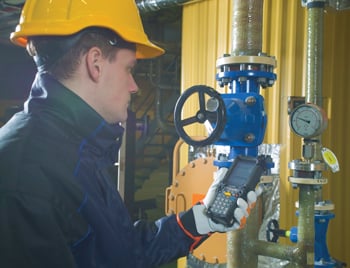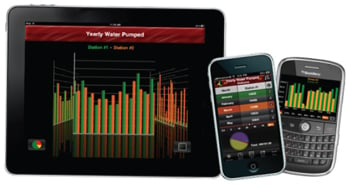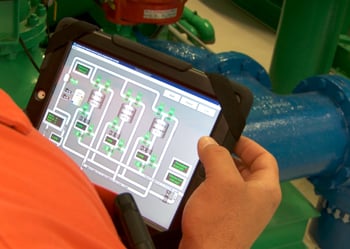This post was authored by Lane Swensen and Kim Custeau of AVEVA.
Today’s workforce is on the go, and mobility is the new norm. Operational information is no longer limited to the traditional control room, but instead extends well beyond physical plant walls – available anytime, anywhere, to anyone who needs it.
By leveraging effective processes, along with smart phones and other hand-held devices, companies are able to increase workforce efficiency through the secure acquisition and integration of more data than ever before.
The latest technologies are designed to address the issues of increasingly sophisticated automation systems and a changing workforce. These solutions give plant operators real-time information, highly capable decision support, and workflow tools. Empowering employees with tools and “know-how” enables them to make better, faster decisions, while simultaneously following a company’s defined best practices.
By using technology solutions tailored for the realities of today’s streamlined, yet highly technical, industrial environment, companies can accelerate and sustain process improvements, making operations more reliable, efficient, safe, and profitable. Remote-monitoring and operations capabilities surrounding business processes and workflows, asset-condition monitoring, and reporting are some of these technology solutions.
Mobile and wireless solutions can be highly effective on-the-job tools for operations management. They help organizations accurately collect field data. A mobile workforce, for example, is much better equipped as a matter of business process to understand issues at the source of a problem and to determine the best way to resolve the problem when it can leverage information remotely. Wireless applications enable even broader visibility into operational performance and are vital components of a complete plant and operations management solution that connects all wired and stranded assets. Intelligent workflow technology can also be applied remotely, providing both remote field workers and local desk workers with intelligent on-demand dynamic procedures, pushed to the right people based on company best practices.
These procedures are not just “dumb” documents but rather “smart” procedures with decision-tree logic that ensures proper, auditable steps are followed. Further, collected contextual data can be used for an overall analysis of equipment health. Manufacturing companies typically face a delicate balancing act. They need to meet growing production demands with existing plants and equipment, while reducing costs so as to maximize return on assets and profitability.
To be successful, these companies must find the optimum balance between asset availability and utilization, while fully addressing all the risks (regulatory, environmental, and health and safety) that come with operating in a manufacturing environment. Remote-asset-condition monitoring has a large impact on production by providing early warning of any impending failure and allowing plant personnel to proactively deal with an issue before it causes a costly shutdown or extended outage. Successful companies are able to overcome these four major challenges:
- Proactive and predictive operations and maintenance
- Dealing with complexity
- Knowledge management
- Communication and coordination
 Remote access to information enables a field operator to quickly resolve an issue in the field.
Remote access to information enables a field operator to quickly resolve an issue in the field.
Condition-monitoring technologies enable the move from a reactive or preventative mode of operation to a proactive and predictive one. When an organization understands the condition of assets, it can do the maintenance activities on an as-needed basis, rather than being reactively driven by unplanned asset failures or simply by the calendar. As a result, the activities of operators and maintenance personnel are more closely aligned with the real-time condition and reliability of assets based on collected key performance data.
A capable solution should eliminate the distractions operators traditionally face, such as alarm storms, manual control of process loops, and tuning/optimization of those same loops. With the distractions eliminated, operators can then focus on true effectiveness by enhancing their skills and knowledge.
Multivariable expert systems with rule-based analysis engines provide context and knowledge management, managing remote operations and instigating the appropriate action. This automates communication across all key groups and individual stakeholders through a variety of media, including email and pager notifications.
This includes escalations, tracking and audit trails, and powerful reporting capabilities. The combination of mobile solutions and a remote architecture to gather, process, and disseminate asset-related information, which is reviewed in its complete context (versus isolated pieces of data) and acted on across the organization, brings together operations, maintenance, and engineering to solve any issues efficiently and effectively.
Mobile reporting capabilities
Data collection, while certainly important, is not sufficient. It has to be integrated, based on best practices, into business operations. Among the hottest mobile-reporting technologies today are smartphone and tablet apps and cloud computing. Just about everyone has a smartphone or tablet, and advanced apps leverage this technology, so plant data is always available on the preferred mobile device. Increasingly, successful companies are using cloud computing to give their workers important company information-securely and cost-effectively.
The best mobile solutions use the cloud to provide critical plant performance data at the lowest possible cost, enabling decision makers in the process, power, and manufacturing industries to be better informed of their facilities' operational performance.
- The benefits of mobile reporting include:
- Readily available critical data: Connect with any corporate or production-system data source. Virtually any electronic data that is delivered to a desktop can be transformed into a graphical report for real-time viewing on a mobile device.
- Graphical reports: Preferred reports can be readily viewed as tables or graphically, e.g., pie charts, bar charts, and line graphs. Information is displayed in a graphical format that is optimized for the device's screen to minimize left-right scrolling.
- In-depth analysis: Leverage the mobile device's touch-screen functions to manipulate charts and graphics for further analysis. Zoom in for areas of interest, or zoom out to see the big picture. One can even view two reports or two elements within a report at the same time for easy comparison.
- Real-time data: Data from configured sources is real time, so the most accurate and reliable information is readily available to assist decision making.
 A state capital's public works department empowers its operators and engineers with smart devices to monitor and control the city's water, wastewater, transportation, and energy systems.
A state capital's public works department empowers its operators and engineers with smart devices to monitor and control the city's water, wastewater, transportation, and energy systems.
 Remote access results in increased situational awareness and unprecedented mobility.
Remote access results in increased situational awareness and unprecedented mobility.
More informed decisions-remotely
Operating more efficiently and profitably requires constant effort, and, importantly, the tools employed must be focused on specific needs and goals. An operator away from the office should not be at a disadvantage. Indeed, today's better, more informed decisions are based on real-time information that is accessible from anywhere, at any time. Whether on the road or away from the office, critical business information is always available. Proven, cost-effective technology exists today that can make step-change improvements in a company's remote-monitoring and operations activities.
About the Author
Lane Swensen is a senior product marketing specialist at AVEVA., involved with industry and infrastructure software solutions. He has an MBA from the University of Nevada, Reno.
About the Author
Kim Custeau is director of product marketing, asset management at AVEVA, handling the enterprise asset management and hand-held mobile workforce solutions. She is a graduate of Mohawk College in Hamilton, Ontario, Canada.
A version of this article also was published at InTech magazine.



